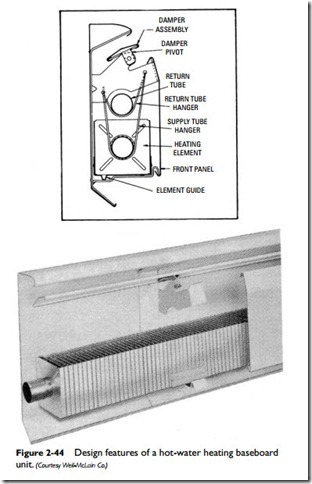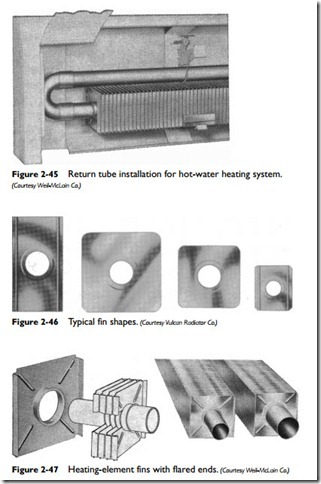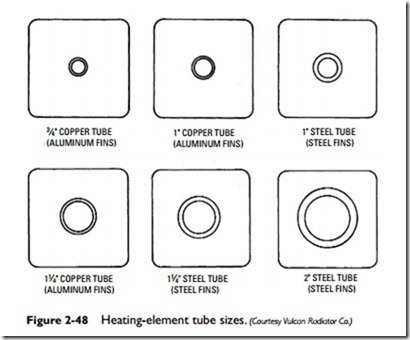Construction Details
Two types of baseboard heaters are used in steam and hot-water (hydronic) heating systems: those with separate fins attached to the tubing and those with the fins cast as an integral part of the unit. The integral-fin units are made of cast iron. Those with separate fins are made of nonferrous metals such as copper, aluminum, or alloys.
Separate Fin-and-Tube Baseboard Units
An example of a baseboard heater with the fins attached to the tubing is shown in Figure 2-45. The size and length of the tube, as well as the number, size, and spacing of the metal fins, will vary from one manufacturer to the next. Fin shapes, sizes, and spacing can be ordered to specification from the manufacturer. Basically the fins are either square or rectangular (see Figure 2-46). Some will have special design features, such as flared ends (see Figure 2-47).
The assembly of the heating element is covered by a sheet-metal enclosure. Openings are cut into the face of the cove to increase air circulation. When steam or hot water is passed through the tube, the heat is transmitted to the fins by conduction through the metals. The heat transmitted to the fins is transferred to the air by convection.
The heating-element tube is available in a variety of sizes, including 3⁄4, 1, 11⁄4, and 11⁄2 inches (see Figure 2-48). On short pipe runs, the 3⁄4-inch tube is recommended in order to ensure water velocities in the turbulent flow range. On long runs and with loop systems, it may be desirable to use 1- or 11⁄4-inch tube sizes.
Use of the small tube sizes results in lower cost for connecting piping in a run and for valves, expansion joints, balancing cocks,
and fittings. There is also a lower heating-element cost involved with the small tube sizes.
The fins and tubing can be made of the same or different metals (see Figures 2-49 and 2-50). The following combinations are among those possible:
1. Copper fins on copper tubing.
2. Aluminum fins on copper tubing.
3. Aluminum fins on aluminum tubing.
4. Aluminum fins on steel tubing.
5. Stainless-steel fins on stainless-steel tubing.
6. Cupronickel fins on cupronickel tubing.
These different metals exhibit different heating characteristics, and all are not suitable for the same application. For example, steel heating elements are recommended for high-temperature water systems. Copper-aluminum elements, on the other hand, work well with water temperatures up to 300°F. Copper-aluminum heating elements also produce a high heat output, but the copper tube has a very high rate of expansion (higher than steel). All these factors
have to be taken into consideration when selecting a suitable heating element for the installation.



